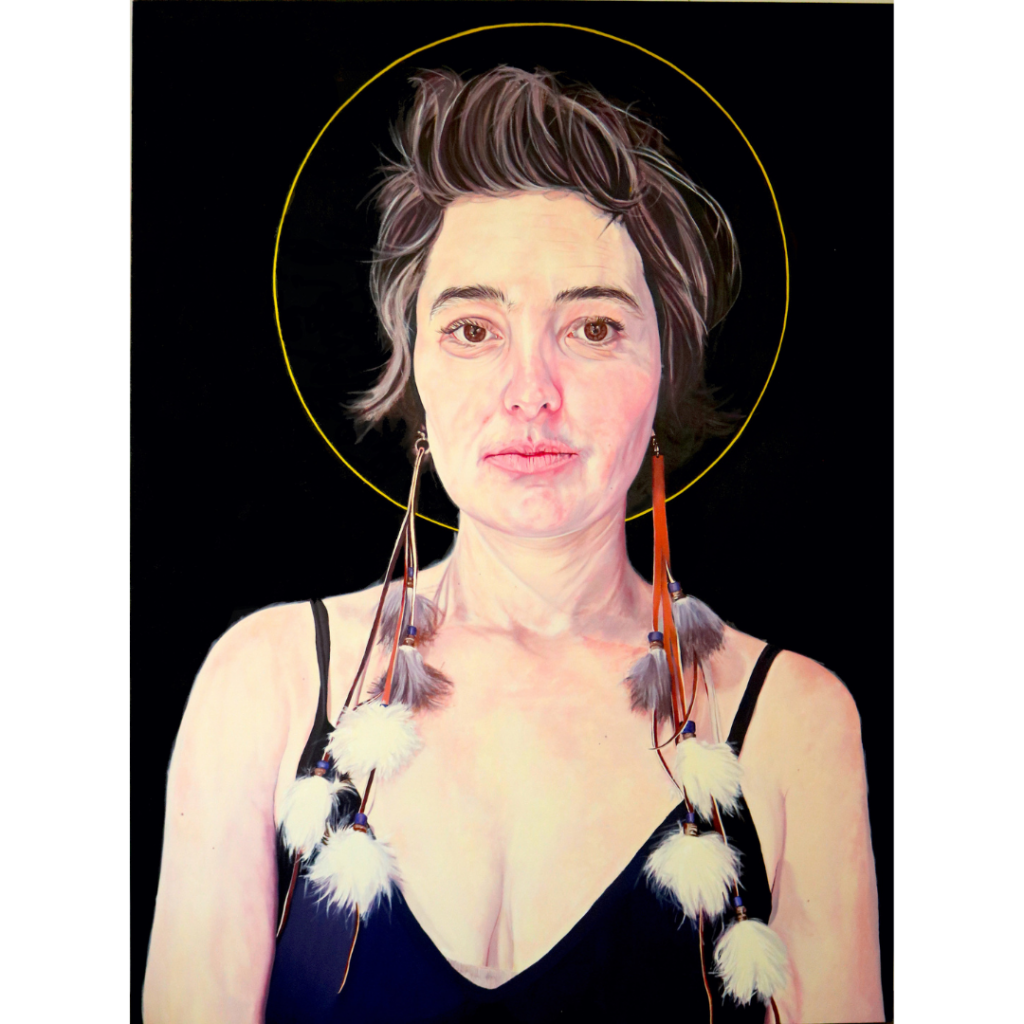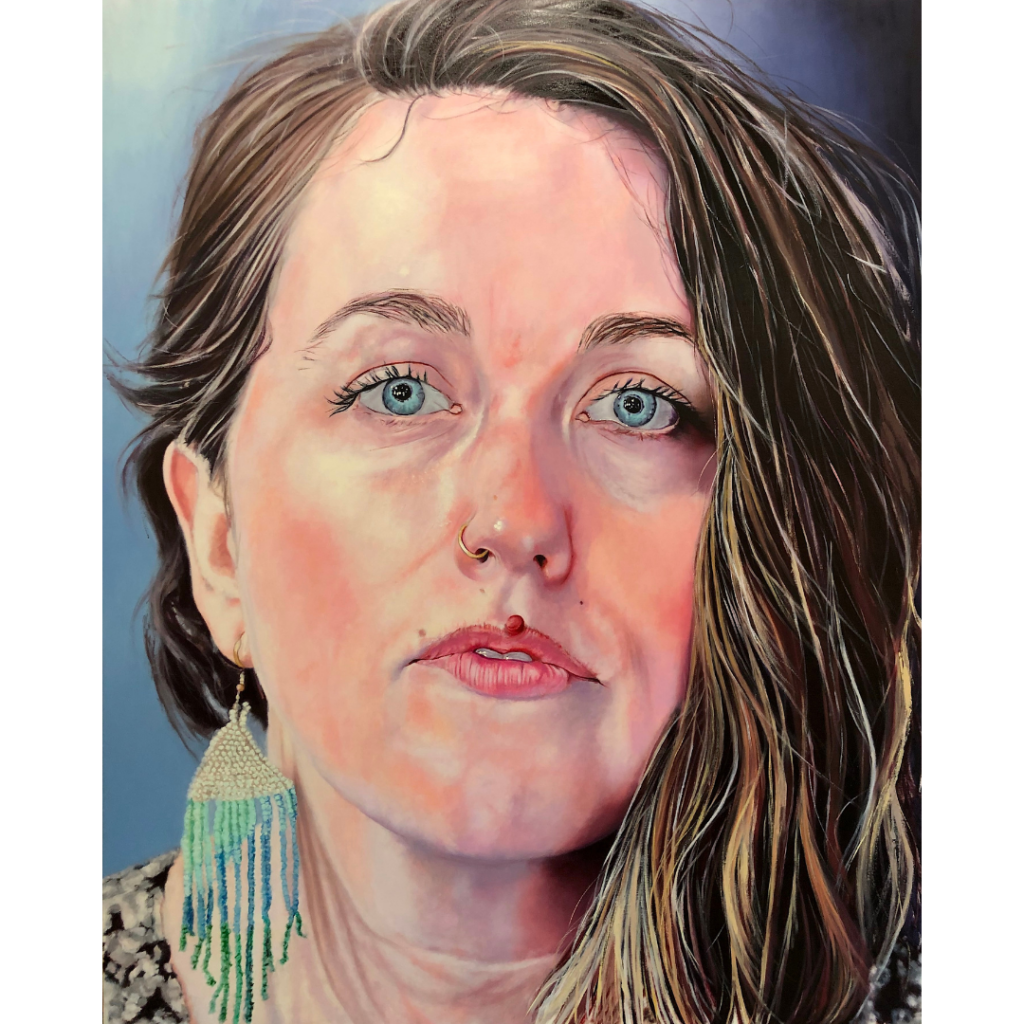MIXD Gallery is joined in conversation with Ray Allen Parker, an artist currently living and working in Fayetteville, Arkansas. In dialogue with the MIXD team, Allen Parker speaks to his career as a portrait artist, his inspirations and comparisons, and the mysterious compulsion to capture the face and essence of the subjects surrounding him through painting.
Portraiture is such a central part of your practice—can you tell us why and how it has inspired your work?
Ray Allen Parker I never wanted to be any other kind of artist than a portraitist. On the first day of the first grade, I drew a picture of my teacher, who snatched it off my desk and hung it on the blackboard in the front of the class, to my great embarrassment. Later, as a child, I saw a TV special about Rembrandt’s self-portraits, and I was overwhelmed by this story of a painting series that chronicles a man’s life and his progress as an artist.
I see Rembrandt’s paintings standing in comparison to the plays of Shakespeare (a near contemporary), beautiful and moving works that represent the arc of a young man’s artistic facility to his old age, demise, and seeming irrelevance. My very first paintings from my one undergraduate art class (discussed below) acted on this same impulse, portraying the lyrical beauty in the human face along with the elegiac nature of the human condition itself. This is the complexity I’m still seeking in my portraits to this day.
What do you most want to convey through your work?
RAP I’m basically trying to answer one question through my portraits: What does it feel like to be alive? That is, what is the essence of being human, and by extension, what can we learn about ourselves by examining others? Simple questions that yield a whole new complex set of answers with each person I paint!

Why do you think people have any sort of hesitation about having other people’s portraits in their homes? How can we continue to educate others on the importance of portraiture art?
RAP Great question! It’s definitely a common reaction. I always ask if they’d like to have the Mona Lisa or a Rembrandt self-portrait … neither of whom they’ve ever met. Of course, the answer’s always an emphatic Yes! I think it’s a matter of understanding that a portrait can move or mesmerize us or inspire us through its formal elements—color, line, mark making, etc. —just as landscapes or abstracts do and that. Furthermore, a portrait can project a mood, a mystery, a spellbinding majesty, like the Mona Lisa, that compels and rewards our continued slow looking. I believe that’s the essential reason why people line up to see it in the Louvre. What could be better?
I’m basically trying to answer one question through my portraits:
RAY ALLEN PARKER
What does it feel like to be alive?
Do any of your relationships inform or influence your work?
RAP In my mind, I have an almost sacred obligation to the people I portray: I want the painting to honor them. The portrait must look like them but it also must feel like them too. It helps me to know the person before starting a portrait, to create an image that matches what I already sense. But after staring at someone’s features for more than 100 hours, you feel you know them very well, almost as well as you know yourself. And many of the people I paint become close, special friends. Some though, a few, may never speak with me again. It happens. The revealing frankness of a large portrait may be too embarrassing, too intimate, too public. You never know. That’s the exquisite mystery of the human condition, isn’t it? Sounds like another woo-woo answer, I know. But that’s the reason why I keep painting, seeking to uncover and understand that essence.
How long have you been making art?
RAP I’m a slow starter … or a late bloomer. Take your pick! I drew constantly as a child, as I mentioned. But with no art classes offered at my rural Northeast Arkansas high school, I took only a single undergrad painting course at the UofA — totally on a whim with overwhelmingly unjustified confidence — only then to abandon art-making for four decades. It just seemed to demand so much. I plunged back into my art education when I retired from an advertising and communications career in 2011, wanting to give myself a better, second shot at something that felt personally important, something I denied myself or missed out on. I’ve been painting full-time ever since.
Who are your favorite artists?
RAP I have a pantheon of portrait-artist heroes: Rembrandt, Gerhard Richter, Jenny Saville, Odd Nerdrum, Lucian Freud … whose art books are scattered all over my studio floor for inspiration & instruction. I’m also inspired by many contemporary painters—Alyssa Monks, Aleah Chapin, Colleen Barry, Roberta Coni, Elizabeth Peyton— female artists all, who are doing the most extraordinary work in portraiture today.
What does work/life balance look like for you as an artist?
RAP I usually paint about 30 hours a week, going to my studio mid-morning and working until early in the evening, Monday-Friday. I eat lunch out with my wife Mary Jean as often as possible to get out of my studio (and to see new, potential painting subjects). Mary Jean assists with photo editing and offers needed painting criticism (more often correct than I’m always willing to admit). At night we binge on long-form cable dramas … the longer the better. I particularly like Babylon Berlin and Borgen. Late at night and early in the morning I read. On weekends I rest my aching feet, sore shoulder, and stiff neck and recharge my creative batteries with movies, bookstore visits, and friends. It’s a schedule I’ve arrived at over more than a decade of painting, so that I’m always eager to begin my creative day and ready to end after hours of hard work. So that I’m always happy—more or less—and productive, no matter what I’m doing.
Can you describe your creative process?
RAP After I’ve chosen a model (someone I know or even recently met), it all begins with a high-quality, well-lit, large-file image taken with a DSLR camera & huge portrait lens in my studio. I typically shoot 300-500 images of the person I want to paint at a fairly close range to find the one picture that captures the person the way I see them in my mind. From there I draw a pencil image of the person on the surface of the large canvas that I’ve wet-sanded, resanded & wet-wiped between multiple layers of gesso until I get a hard, smooth surface with still a bit of tooth. Then I begin painting, working from the chosen image on my iPad. I use small, long-handle, red-sable filbert brushes, mixing paints on a glass-top palette on a rolling cart next to me.
I work from a relatively small, steady cast of paint colors— typically 8-10. But I also incorporate a number of guest-star colors, depending on the specific nature of the image, say, two or three different reds or yellows. I work from the darkest-dark areas, filling in paint wherever it makes sense, to the mid-darks; then starting over and continuing from the dark darks all the way to the lightest darks and eventually to the mid-tones and lighter areas. I’m painting all over the canvas at this point, so the entire image comes up together, trying to keep every part of the image unresolved for as long as I can stand it. In the end, I finally add my lightest lights and highlights. I may also introduce a couple of special guest-star colors at this point, a raw unmixed hue, like Kings Blue or Radiant Violet, to scumble in and add a bit of pop on the finished image, sort of a perfectly imperfect color in just the right spot. I do this using my fingers, pressing or dragging, or smudging the paint into the canvas weave. I try to have a couple of canvases going simultaneously. This prevents me from being so obsessive about the image in process and allows me to see it freshly on the days I work on it.
I photograph my work at the end of each day so I can see how far I’ve come & how its progress tracks vs. similar paintings. I feel I’ve finished when the portrait still feels real and vital, when there are no mistakes I can’t live with, when there’s nothing else I know to do. Mostly, I listen to audiobooks while I’m working, particularly biographies, but also podcasts about painters. When I do blast music, it tends to be the same old thing over and over. For comfort or to put me in just the right headspace, I guess. I’ve been listening to Beatles ’65 for months.

Do any other interests influence your art? What are they?
RAP Certainly film! Think of the chiaroscuro of the Brando scenes in Apocalypse Now, the over-saturated, lyrical sequences in Wong Kar Wai’s movies, and the intense face close-ups in Sergio Leone’s spaghetti westerns. But also photography, particularly Richard Avedon’s iconic portrait series In the American West and Richard Learoyd’s gigantic camera obscura images. And literature! I recently completed 17 portraits of literary figures based on historical photos, entitled LIT, a sort-of visual chronicle of the novelists and poets who shaped my own intellectual and emotional development.
Have you read anything good lately?
RAP I recently read Haruki Murakami’s The Wind-up Bird Chronicles and Toni Morrison’s Beloved. And I just finished Demon Copperhead, a retelling of David Copperfield set in contemporary opioid-ravaged Appalachia. It’s a moving, harrowing tale, particularly if you’ve read the Charles Dickens original.
What do you like or dislike about the art world?
RAP I love being an artist, something that nourishes and excites me and provides me with the purpose I was seeking for so many decades. I love the friends I’ve made along the way, my fellow art makers, whose work and ambition, and accomplishments inspire and thrill me, as well as my models and my clients, who share and admire my vision of what constitutes art and makes life worthwhile. But it can also get lonely and frustrating in the studio. And sometimes, people seem afraid of art or are unwilling to engage with it for fear they won’t understand it. There can be a sense that art is like eating your vegetables: They just won’t like it. But if they’d only try it, they might find the essence of something they’ve never encountered before, that can enhance and sustain their lives. Isn’t that what most people are looking for?
What are you excited about next in your work?
RAP I’m starting a new series of portraits, smaller and more intimate, more about the sitter’s emotional essence than their physical appearance. I’m taking inspiration from the Japanese ceramic technique Kintsugi, which treats the breakage and repair of an object as a strengthening part of its history rather than as something to hide. So far everyone I know qualifies! In these, I’m trying to leave in and embrace my mistakes & color accidents and achieve something that’s as much paint as a person. I’m also taking inspiration from recent works by Jenny Saville and Aleah Chapin, in particular, who seem to recognize and emphasize this painterly, psychological approach to portraiture.
Introduction by Rachel Roberts
Interview by Kaitlin Morelock